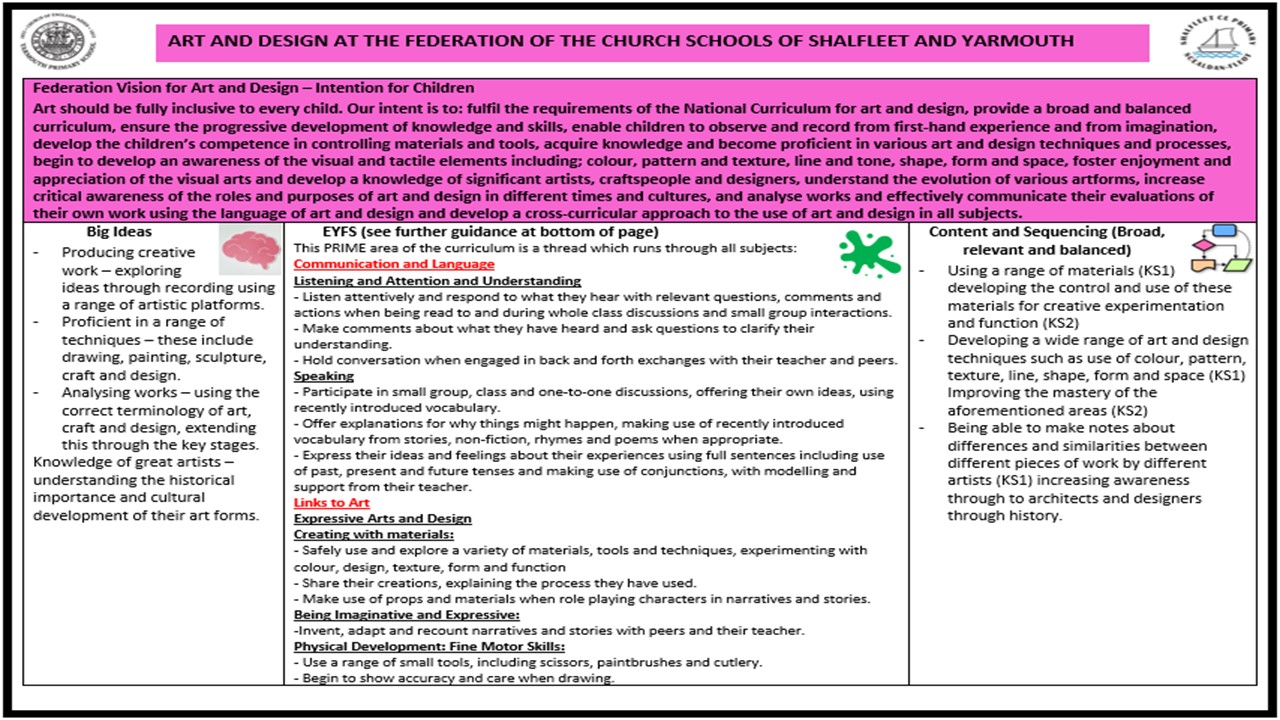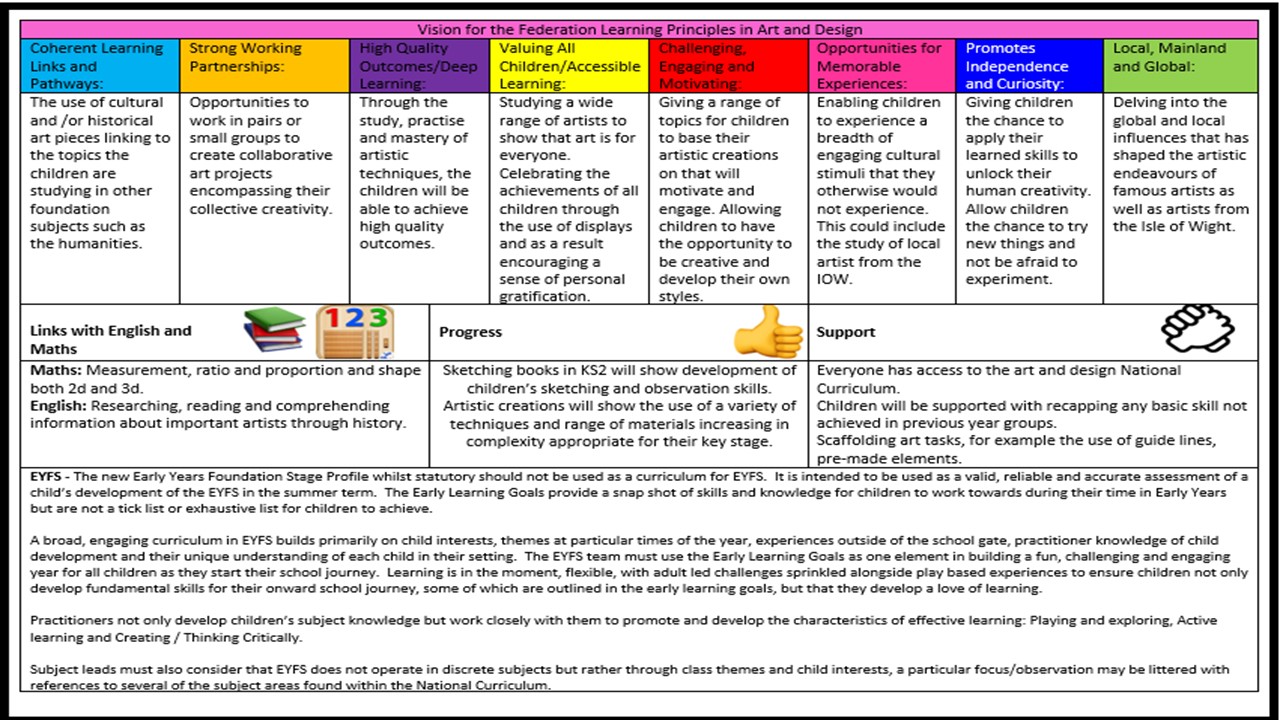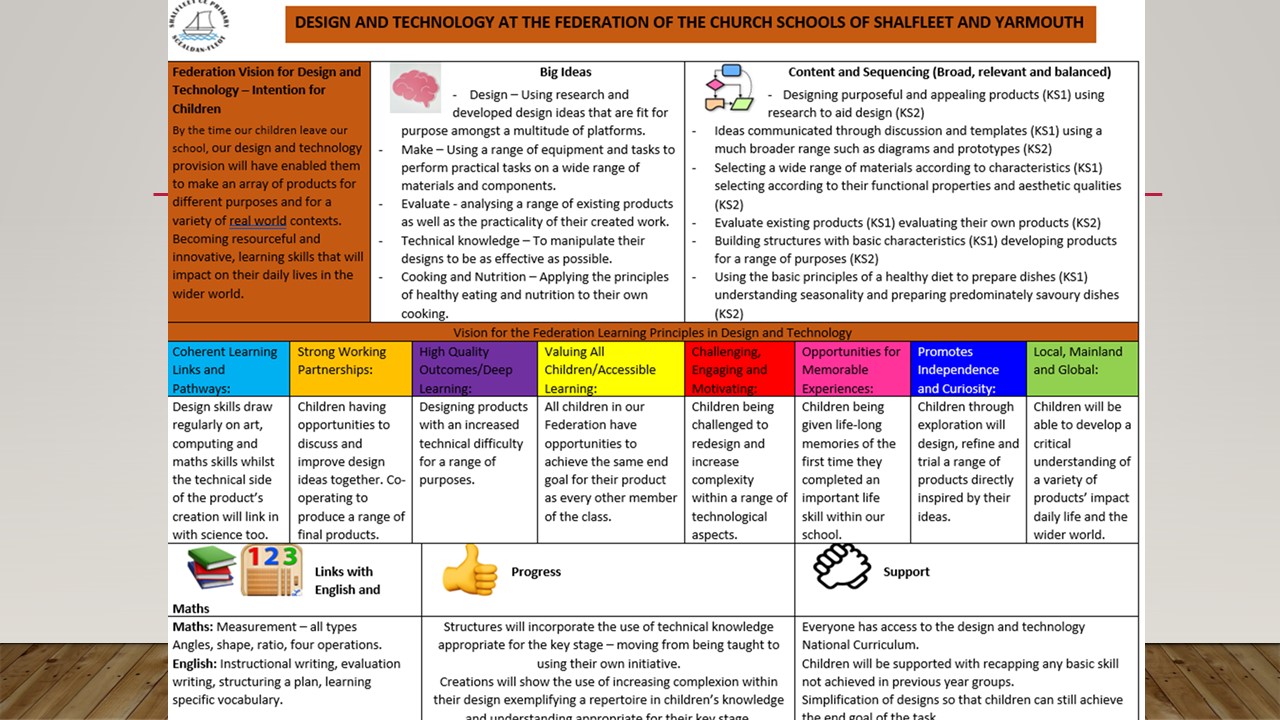curriculum
Art & Design TechnologyArt
National Curriculum Statement
Purpose of study
Art, craft and design embody some of the highest forms of human creativity. A high-quality art and design education should engage, inspire and challenge pupils, equipping them with the knowledge and skills to experiment, invent and create their own works of art, craft and design. As pupils progress, they should be able to think critically and develop a more rigorous understanding of art and design. They should also know how art and design both reflect and shape our history, and contribute to the culture, creativity and wealth of our nation.
Aims
The national curriculum for art and design aims to ensure that all pupils:
*produce creative work, exploring their ideas and recording their experiences
*become proficient in drawing, painting, sculpture and other art, craft and design techniques
*evaluate and analyse creative works using the language of art, craft and design
*know about great artists, craft makers and designers, and understand the historical and cultural development of their art forms.
Our Intent
Art should be fully inclusive to every child. Our aims are to: fulfil the requirements of the National Curriculum for art and design, provide a broad and balanced curriculum, ensure the progressive development of knowledge and skills, enable children to observe and record from first-hand experience and from imagination, develop the children’s competence in controlling materials and tools, acquire knowledge and become proficient in various art and design techniques and processes, begin to develop an awareness of the visual and tactile elements including; colour, pattern and texture, line and tone, shape, form and space, foster enjoyment and appreciation of the visual arts and develop a knowledge of significant artists, craftspeople and designers, understand the evolution of various artforms, increase critical awareness of the roles and purposes of art and design in different times and cultures, and analyse works and effectively communicate their evaluations of their
own work using the language of art and design and develop a cross-curricular approach to the use of art and design in all subjects.
Art and design teaching instils an appreciation and enjoyment of the visual arts. Art and design stimulates imagination and creativity; involving children in a range of visual, tactile and sensory experiences, which enable them to communicate what they see, think and feel through the use of the elements of colour, texture, form and pattern. Art and design promotes careful observation and an appreciation of the world around us. Children explore ideas and meanings through studying the work of artists and designers. Through learning about the roles and functions of art, they can explore the impact it has had on contemporary life and on different periods and cultures. It should develop children’s analysis and evaluation skills whilst studying a range of artists, designers and craftspeople throughout history as well as when critiquing their own work.
Design & Technology
National Curriculum Statement
Purpose of study
Design and technology is an inspiring, rigorous and practical subject. Using creativity and imagination, pupils design and make products that solve real and relevant problems within a variety of contexts, considering their own and others’ needs, wants and values. They acquire a broad range of subject knowledge and draw on disciplines such as mathematics, science, engineering, computing and art. Pupils learn how to take risks, becoming resourceful, innovative, enterprising and capable citizens. Through the evaluation of past and present design and technology, they develop a critical understanding of its impact on daily life and the wider world. High-quality design and technology education makes an essential contribution to the creativity, culture, wealth and well-being of the nation.
Aims
The national curriculum for design and technology aims to ensure that all pupils:
- develop the creative, technical and practical expertise needed to perform everyday tasks confidently and to participate successfully in an increasingly technological world
- build and apply a repertoire of knowledge, understanding and skills in order to design and make high-quality prototypes and products for a wide range of users
- critique, evaluate and test their ideas and products and the work of others
- understand and apply the principles of nutrition and learn how to cook.
Our Intent
By the time our children leave our school, our Design Technology provision aims to have sparked children’s creativity and imagination and provided them with the practical skills to bring their ideas to life. They will be confident in designing products, working with a range of tools and materials, developing their evaluative thinking and understanding and applying the principles of nutrition.



Monitoring & Evaluating
Impact of the implementation of the Art & Design Technology curriculum is measured in a variety of ways.
These include:
Pupil Conferencing
Work Scrutiny – alongside teacher’s planning
Assessment data
Learning walks
Learning environment
